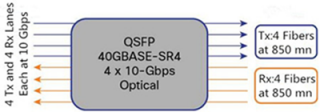40G Parallel & Bidirectional Optical Transceiver Introduction
petak , 29.04.2016.Speeds in data centers have maintained their growth in the past years, and will continue to do so in the predictable future. High-data-rate systems have become increasingly popular among some enterprises for high-performance computing networks, such as 40 Gigabit Ethernet (GbE) infrastructure, in which 40G fiber optic transceivers and cables are needed to ensure the high-performance and great-bandwidth of the 40GbE system. This article mainly introduces 40G fiber optic transceivers: the pluggable optical Enhanced Quad Small Form-Factor Pluggable (QSFP+), with focus on the bidirectional optical transceivers and parallel optical transceivers.
40G Optical Transceiver Types
The transceiver is an electronic device that receives an electrical signal, converts it into a light signal, and launches the signal into a fiber. It also receives the light signal, from another transceiver, and converts it into an electrical signal. With the 40G QSFP being the dominant transceiver form factor used for 40GbE applications, the IEEE standard 802.3ba released several 40-Gbps based solutions in 2010, including a 40GBASE-SR4 parallel optics solution for multi-mode fiber (MMF). Another solution is a bidirectional 40-Gbps transceiver that uses a two-fiber LC optical interface.
40G Parallel Optical Transceiver
40G parallel optical transceiver enables high-bandwidth 40G optical links over 12-fiber parallel fiber terminated with MPO/MTP connectors. Four fibers on one side are used to transmit, while another four on the other side are utilized to receive, leaving the middle four fibers unused. In total, eight of the twelve fiber are used. That is to say, when used for 40GBASE-SR4 and 40GBASE-CSR4, parallel optical transceiver has 10-Gbps electrical lanes that are mirrored in the optical outputs, causing the requirement of eight fibers with a MTP connector interface. Each fiber either transmits (Tx) or receives (Rx) 10-Gbps traffic at a single wavelength.
Just as mentioned above, 40GBASE-SR4 QSFP+ transceiver belongs to 40G parallel optical transceivers, which uses multi-mode MPO trunks to establish 40G links. This port type 40G QSFP+ module can support link lengths of 100 meters and 150 meters over laser-optimized OM3 and OM4 MMFs respectively. It can also be used to connect with four 10GBASE-SR optical interfaces using an 8-fiber MTP to 4 duplex LC cable. Fiberstore listed 40GBASE-SR4 optical transceivers are fully compatible with such famous brands, as Cisco, Intel, Juniper (QFX-QSFP-40G-SR4), and so on. All are quality-and compatiblity-assured, offering the high performance to customers.
40G Bidirectional Optical Transceiver
By contrast, 40G bidirectional optical transceiver consists of two 20-Gbps transmit and receive channels, enabling an aggregated 40-Gbps link over a two-strand MMF connection. That is, the bidirectional optical transceiver used for 40GBASE-SR-BD uses the same 10-Gbps electrical lanes, which are then combined in the optical outputs, thus requiring two fibers with an LC connector interface. Each fiber simultaneously transmits and receives 20-Gbps traffic at two different wavelengths.
Cabling Options for 40G Parallel & Bidirectional Optical Transceiver
Cabling Options for 40G Parallel Optical Transceiver
As previously mentioned, in 2010 IEEE 802.3ba approved the 40GBASE-SR4 physical-medium-dependent (PMD) multi-mode parallel optic solution, which uses eight fibers to transmit four duplex channels each at 10-Gbps. This is an economical path to 40GbE data rates, while using many of components of 10GbE solutions. The main advantage of the parallel optical transceiver over the bidirectional transceiver at 40GbE is the reach. For example, if you cable your data center with OM3 at 10GbE, you can support distances up to 300m. Then if you move to 40GbE, you can support the same 300m distance with the same OM3 fiber and a 40GBASE-CSR4 transceiver. However, if your cabling distances do not justify the extra distance capability, then the bidirectional solution would be used.
There exists a problem in this parallel optical cabling solution—MTP cable assemblies which built on 12-fiber position connectors, leaving four unused fibers in each link. There are several basic cabling options for parallel optics connectivity. One approach is to ignore the unused fibers and continue to deploy 12 fibers. Another approach is to use a conversion device to convert two 12-fiber links into three 8-fiber links.
Cabling Options for 40G Bidirectional Optical Transceiver
This two-fiber 40G bidirectional multi-mode solution tackles the challenge—polarity correction that occurs in a 12-fiber MTP connector., using two different transmission windows (850 and 900nm) that are transmitted bidirectionally over the same fiber. This approach allows the use of the same cabling infrastructure for 40GbE as was used for 1 and 10 Gigabit Ethernet. The pluggable bidirectional transceiver has the same QSFP+ format as the existing 40GBASE-SR4 transceivers. Therefore, the same switch line card with QSFP+ ports can support either parallel optics 40GBASE-SR4 or bidirectional optics 40GBASE-SR-BD solutions.
As such, while connecting a 40GbE bidirectional transceiver to another bidirectional transceiver, a Type A-to-B standard LC duplex patch cord can be considered, with one fiber in connector position A on one end and in connector position B on the other end. Such reverse fiber positioning allows a signal to be directed from the transmit position on one end of the network to the receive position on the other end of the network. However, this direct connectivity is recommended only within a given row of cabinets.
Conclusion
40G QSFP+ transceivers can meet the growing data center applications, such as big data and high-frequency trading (HFT) applications, and virtualized and clustered environments. With 40G bidirectional optical transceivers, no big changes to the existing cabling infrastructure are required, a cost-effective way for migration from 10-Gbps to 40-Gbps connectivity in data center networks. As a professional fiber optical product manufacturer and supplier, Fiberstore offers various 40G QSFP+ transceivers for your choice. Besides, many 40G cables (ie. QSFP-4SFP10G-CU5M) are also available for the smooth migration. For more information about 40GbE solutions (40G QSFP+ and 40G cables), you can visit Fiberstore.
Oznake: 40G parallel optical transceiver, 40GBASE-SR4, QFX-QSFP-40G-SR4, 40G bidirectional optical transceiver, 40G cables, QSFP-4SFP10G-CU5M
komentiraj (0) * ispiši * #


